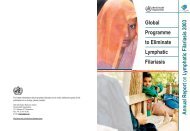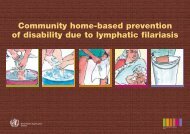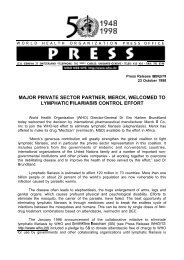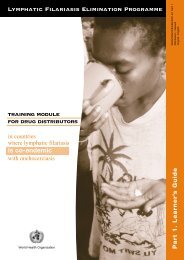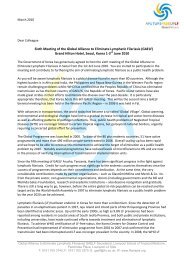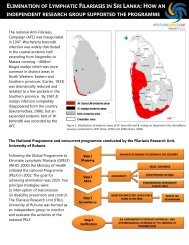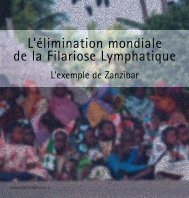English - Global Alliance to Eliminate Lymphatic Filariasis
English - Global Alliance to Eliminate Lymphatic Filariasis
English - Global Alliance to Eliminate Lymphatic Filariasis
Create successful ePaper yourself
Turn your PDF publications into a flip-book with our unique Google optimized e-Paper software.
REPORT OF THE 6 TH GAELF MEETING, JUNE 2010<br />
Keynote Addresses<br />
Chair: Professor Jong-Yil Chai<br />
Seoul National University College of Medicine<br />
The first session of the conference,<br />
chaired by Professor Jong-Yil Chai,<br />
described the successful elimination of LF<br />
in Korea.<br />
A his<strong>to</strong>ry of a country elimination<br />
Professor Han-Jong Rim, Emeritus<br />
Professor at Korea University College of<br />
Medicine, reviewed the his<strong>to</strong>ry of LF<br />
elimination in Korea, which can be<br />
considered in three distinct phases [1].<br />
During the first phase, 1920-1945, LF was<br />
initially recognized as an endemic public<br />
health problem and was found <strong>to</strong> be<br />
caused only by Brugia malayi.<br />
The period 1951-1979 was one of<br />
investigation and surveillance. Three<br />
major endemic areas were identified: Jeju<br />
Island; the southwest coastal area; and an<br />
area in the southeast, which extended<br />
inland. Epidemiologic investigations were<br />
conducted in all of these areas, where<br />
microfilaremia prevalence ranged from 1<br />
<strong>to</strong> 22%. These investigations showed that<br />
B. malayi was nocturnally periodic and the<br />
principal vec<strong>to</strong>rs were Aedes <strong>to</strong>goi, in<br />
coastal areas, and Anopheles sinensis,<br />
inland. No LF transmission was detected in<br />
the central part of the country, which is<br />
mountainous. Persons infected with B.<br />
malayi were treated selectively with<br />
diethylcarbamazine (DEC), beginning with<br />
low doses <strong>to</strong> minimize adverse reactions.<br />
Certain aspects of traditional life were<br />
identified as facilitating transmission,<br />
including the habit of gathering water<br />
during the evenings, and the thatched<br />
roofs, which provided resting places for A.<br />
<strong>to</strong>goi.<br />
Prevalence of infection with soil-transmitted helminthes and gross national product, Republic<br />
of Korea, 1969-1989<br />
15



